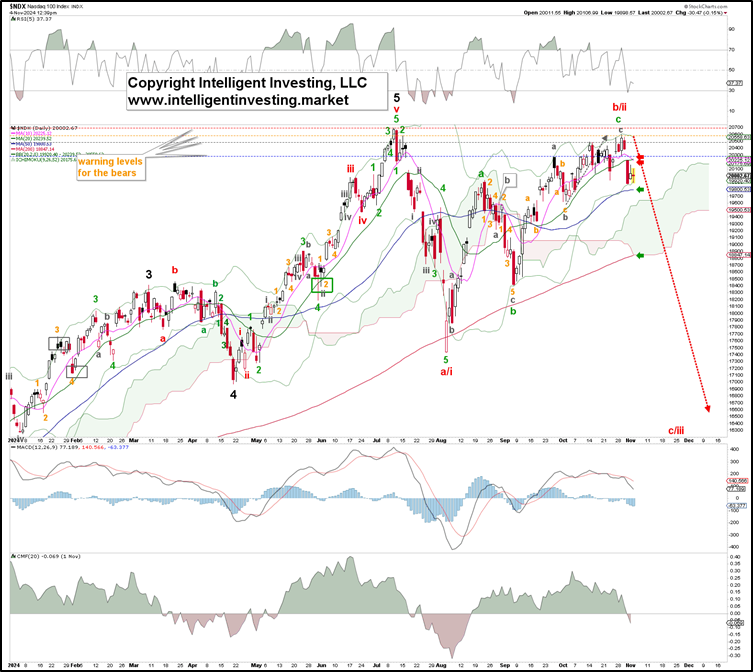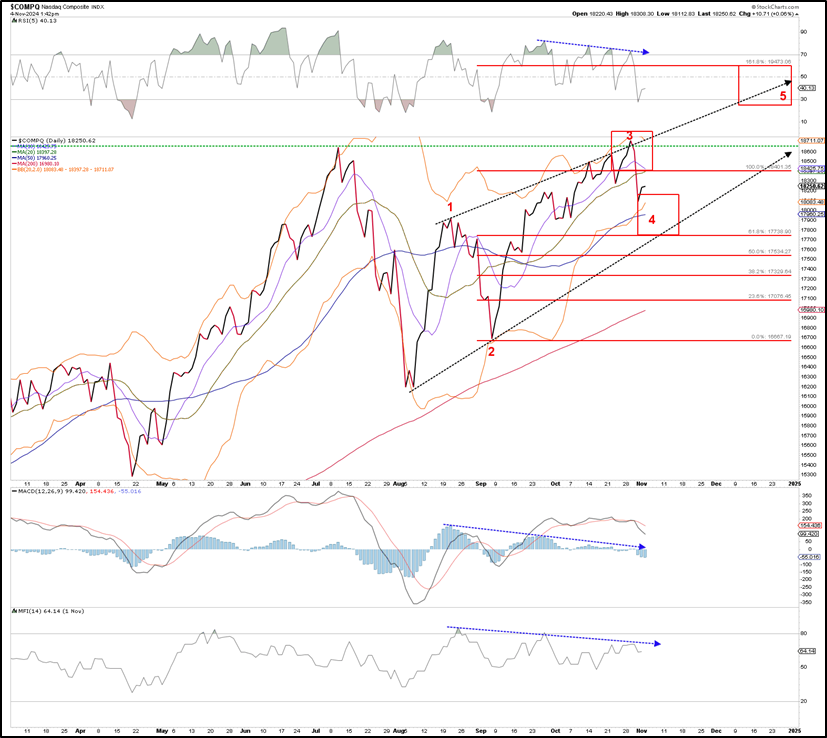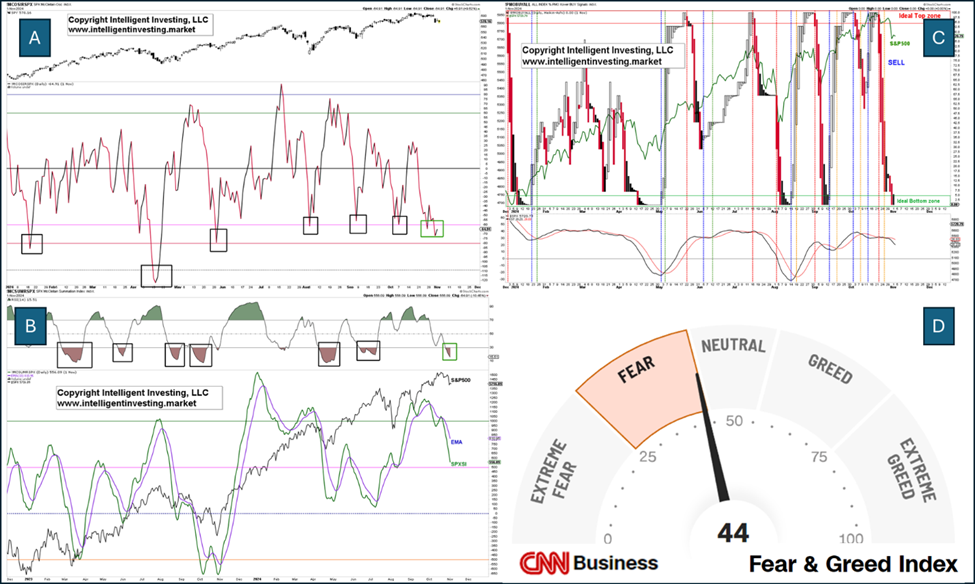If there is one thing the financial markets do not like, it is uncertainty. Of course, who will become the next President of the United States of America is often a considerable uncertainty, especially in the 2024 elections with two opposite candidates. Since the President of the USA wields great economic power at home and abroad, and the stock market is an economic barometer, it is paramount to ask if the outcome of the elections can crash the US stock market.
To answer that question, we should first go back to our previous update from three weeks ago, where we found that the index
“… the index could still be wrapping up a counter-trend rally: the red W-b/ii, potentially targeting as high as $20600, assuming a standard (grey) W-c = W-a relationship. A break below the grey W-b, the October 1 low at $19622, would go a long way to confirm this thesis, with full confirmation below the September 6 low at $18400.”
Fast-forward: The index topped at $20,600.01 last Tuesday, October 29, and has since declined. Thus, the counter-trend red W-b/ii, see Figure 1 below, is still alive and well, but the Bears have yet to push the index’s price even below the October 1 low. Thus, while we keep the warning levels for the Bears as is, we still cannot exclude the Bullish potential setup in the charts. Allow us to explain below.
Figure 1. NDX daily chart with detailed Elliott Wave count and technical indicators
Before the bears get too excited, please note that
A) The NASDAQ (NAS) made a new all-time high (ATH) last week, which excludes the red W-b/ii setup for that index. Since the NDX and NAS are often tied to the hip, it is uncommon for the two to have vastly differing EWP counts. Namely, as explained in our previous update, if the Bears cannot hold the index's price below the July ATH, we must focus on the alternative EWP count in Figure 2 below, which is the “dreaded” ending diagonal (ED).
Figure 2. NASDAQ daily chart with detailed Elliott Wave count and technical indicators
As explained in our previous update,
“In an ED, the 3rd wave … typically targets the 1.236x Fibonacci extension of the [1st wave], measured from the [2nd wave] low, … . From there, a correction, [the 4th wave], can target typically, but not necessarily, the 61.8-76.4% Fib-extension … before the [5th wave] kicks in, to ideally the 161.8-176.4% Fib-extension … .”
This also applies to the NASDAQ. Figure 2 shows that it is following this ED pattern rather well. This path is contingent on holding above the September 6 low, though the potential 4th wave, as shown, can become more protracted, i.e., a bounce followed by another move lower before the final 5th wave starts.
B) Market breadth readings and sentiment are getting pretty washed out. See Figure 3 below. Although these are conditions, i.e., these readings can always become lower, and the indexes’ price is always the final arbiter, the McClellan Oscillator (3A), Summation Index (3B), and PMO (3C) are all at levels from where previously good buy signals occurred. Meanwhile, sentiment is fearful. Thus, the path of least resistance for these indicators appears to be up, which can propel the indexes higher.
Figure 3. Several market breadth indicators and the CNN Fear & Greed Index
The bottom line is that the Bears stopped the advance right where they had to (NDX20,600) and still have a shot at hammering out a multi-year top. However, a break below at least the October 1 low, especially the September 6 low, is required to confirm this thesis. Otherwise, the Bulls can run with it. Meanwhile, market breadth and sentiment are getting pretty washed out, which favors the Bulls, if only for a “dead cat bounce.”
The analysis is derived from data believed to be accurate, but such accuracy or completeness cannot be guaranteed. It should not be assumed that such analysis, past or future, will be profitable, equal past performance, or guarantee future performance or trends. All trading and investment decisions are the sole responsibility of the reader. The inclusion of information about positions and other information is not intended to be any type of recommendation or solicitation.
Recommended content
Editors’ Picks

EUR/USD struggles to find upside traction near 1.0950
EUR/USD remains below the 1.1000 barrier and trades with humble losses on the back of the acceptable rebound in the Greenback, as market participants continue to adjust to Trump's announcement of a 90-day pause on reciprocal tariffs on non-retaliating countries.

GBP/USD retakes 1.2800 and above
GBP/USD manages to keep the bullish bias despite the decent bounce in the US Dollar, navigating the area above 1.2800 the figure as investors continue to assess the ongoing US-China trade war. US doubles the bet, announced 125% levies on Chinese imports.

Gold remains bid, refocuses on $3,100
Prices of Gold now regain some balance and approach the $3,100 zone per troy ounce on Wednesday after President Trump announced a 90-day pause on reciprocal and 10% tariffs. FOMC Minutes pointed to further caution from officials.

Dow Jones Industrial Average rockets 6% higher on tariff suspension
The Dow Jones Industrial Average (DJIA) skyrocketed on Wednesday, surging over 6% on the day and returning to the 40,000 handle after the Trump administration announced yet another pivot on its own tariff policies.

Tariff rollercoaster continues as China slapped with 104% levies
The reaction in currencies has not been as predictable. The clear winners so far remain the safe-haven Japanese yen and Swiss franc, no surprises there, while the euro has also emerged as a quasi-safe-haven given its high liquid status.

The Best brokers to trade EUR/USD
SPONSORED Discover the top brokers for trading EUR/USD in 2025. Our list features brokers with competitive spreads, fast execution, and powerful platforms. Whether you're a beginner or an expert, find the right partner to navigate the dynamic Forex market.






